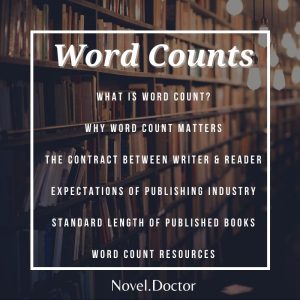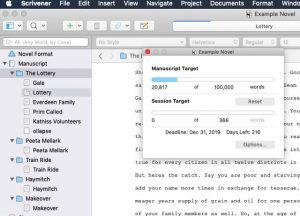Professional writers measure their progress word by word. As you’ve read in my article about writers’ daily word production, many famous authors measure their writing progress by tallying up every word they write.
Writers have made their reputation with works of variable length. The Lord of the Rings by J.R.R. Tolkien was originally one book with 576,459 words. Ernest Hemingway wrote The Old Man and the Sea as a short 27,000 word book. In the 1800s, Anthony Trollope was famous for writing many hundreds of thousands of words in his books. Other writers — like Lord Byron — established their fame by telling stories in poems of under 10,000 words!
Today, in our current publishing market, particular genres of book are constrained to specific word-count lengths. A children’s book, for example, would never go above 100,000 words, except in unique circumstances. An adult novel would not be under 40,000 words, while nonfiction business books typically are in between those two counts.
To sell your book in the current market, you should pay close attention to these word count lengths and tailor your book to the market. This post outlines the basic word count length for fifteen genres of writing.
Why word count matters
 If you have a brilliant idea, you probably know that you could write about this story for decades. You could write a trilogy — even a decalogy! You could go on for hundreds of thousands of words.
If you have a brilliant idea, you probably know that you could write about this story for decades. You could write a trilogy — even a decalogy! You could go on for hundreds of thousands of words.
However, if you want anyone else to read your story, it’s important to keep in mind the idea of a contract with your reader.
Readers pick up a book with a specific idea about that book. For example, when a 12-year-old picks up a story that they are interested in, they expect to finish that book in about a week. That means they expect the book to be between 20,000 and 50,000 words. This is a kind of inherent contract: the reader expects one thing, and you as the writer deliver that experience.
The same is true of other genres. When a businesswoman in the airport picks up a romantic thriller to read on the plane, she expects an escapist story that will take her out of her constrained travel arrangements for the next six hours or so. The romantic thriller will include some pulse-pounding action, character development (and an exciting romantic connection). And yet, she’ll be able to finish the book fairly quickly. So the thriller should be between about 75,000 and 90,000 words. This again is an inherent contract between the reader and writer.
To be clear, there are exceptions to every rule. Stephen King and J.K. Rowling get these exceptions — because they’ve made millions of dollars for publishers. Yet their inherent contract with readers is different than yours. Readers have enjoyed their work for decades, so readers extend them much more trust. You, as a beginning writer, need to prove yourself to readers. And part of proving yourself is delivering a good story in a particular word count.
Finally, as we discuss the average word count for particular genres, let’s think for a moment about Mark Twain’s experience of a daily word count. He set a goal, and he strove to accomplish that goal. He knew approximately how many words he had to write to complete his book.
In the same manner, your knowledge of your genre’s word count can be a forcing function to help you make progress toward your goal. You can chart your writing progress as you sail closer to your destination and plot your way across the sea of words to safe harbor.
The average length of a book
Today, with the advent of digital publishing and print-on-demand publishing, more books are being published than ever before in the history of human civilization. This is a great benefit to readers. But this also means that books have settled into very specific lengths. By following this word count guide for every book genre, you can also measure your progress and chart your success.
Publishers typically consider a book to be “novel-length” when it’s between 50,000 and 120,000 words.
Writer’s Digest states that 80,000 to 89,999 words is the “100% safe range for literary, mainstream, women’s, romance, mystery, suspense, thriller and horror.” Before a book is collated for publication, that length means that you can produce approximately 300 pages of double-spaced type.
Editor and writer Shawn Coyne uses the Nanowrimo word-count length of 50,000 words as a baseline and describes 50,000 words as a good foundation for your next revision (Read Coyne’s piece on StoryGrid about Outlining Your Book in 3 Easy Steps for more helpful hints).
This means that as an author you should target 50,000 words as the bare minimum. Ideally, once you start building towards a more publishable version of your manuscript, aim higher, for at least 90,000. Many writers write long — turning in over 100,000 words with their first draft. That’s when they have to start trimming back towards the 90,000-word mark.
Revision and editorial cutting are key components of any writing practice.
Word count standard lengths
Remember that 12-year-old who picked up your book? And that businesswoman in the airport? You have an inherent contract with those readers to deliver the books they expect, including the word count they expect.
Different genres have different word counts.
Here are the average word-count ranges by genre in today’s publishing market, as derived from analysis done by Writer’s Digest and other publications:
General Fiction
- Flash Fiction: 300–1500 words
- Short Story: 1500–30,000 words
- Novellas: 30,000–50,000 words
- Novels: 50,000–110,000 words
Fiction Genres
- Mainstream Romance: 70,000–100,000 words
- Subgenre Romance: 40,000–100,000 words
- Science Fiction / Fantasy: 90,000–120,000 (and sometimes 150,000) words
- Historical Fiction: 80,000–100,000
- Thrillers / Horror / Mysteries / Crime: 70,000–90,000 words
- Young Adult: 50,000–80,000
Children’s Books
- Picture Books: 300–800 words
- Early Readers: 200–3500 words
- Chapter Books: 4000–10,000 words
- Middle Grade: 25,000–40,000 words
Nonfiction
- Standard Nonfiction: 70,000–80,000 words
- Memoir: 80,000–100,000 words
- Biography: 80,000–200,000 words
- How-to / Self-Help: 40,000–50,000 words
Note that the list of book lengths above are average ranges for word counts. These should not be seen as specific end-points for any story or business book. If your self-help book is 51,567 words, that’s fine. If your thriller is 69,000 words, that’s fine too. You should write to hit somewhere in the target range to achieve the expected outcome and to fulfill that inherent contract with your reader.
You can use these word counts as a baseline for your writing practice.
Words per page
Your Writing Progress
The short answer to this question is that writers produce a double-spaced manuscript page with a one-inch margin on every side. A page in this standard format, in a standard 12-point font like Times New Roman, sums up to about 250 words per page. This means that if you have 4 pages, then you have written about 1,000 words.
Now if you use a pen and paper, I can’t tell you precisely how many words are found in your hand-written manuscript pages, because handwriting varies so much.
Published Word Counts
A published book that contains about 100,000 words will be about 400 pages in printed form, depending on layout, font choices and the final published layout.
Note that other formats, such as specialized business books with many illustrations or children’s books with illustrations, often space text out in ways that make the page count longer, while the word count may be shorter and smaller.
Tools for word count
Most writers today use a word processor on their computers, such as Microsoft Word or Apple Pages or Scrivener. All of these programs have a built-in word count feature that is readily available.
Microsoft Word even shows your running word count in the lower left-hand corner of your screen. You can watch your word count grow as you continue to type. (Here’s a brief overview of Word Count in Microsoft Word.)

If you’re using an online system to write, such as Google Docs, then word counting is also available as a feature. (Here’s a brief overview of Word Count in Google Docs.) If you’re using a different tool, and you want a simple way to count words, here’s an online word counter.
For writers who prefer Scrivener, there are a number of features in this great tool that can help you calculate your progress and adjust your writing schedule to accommodate your plans and goals. (Here’s a brief overview of Word Count in Scrivener, courtesy of writer April Dávila.)
And here’s where to find the word count feature in Evernote (note that Mac Evernote doesn’t have this feature yet).
How to use word count
If you calculate your daily word production against your overall book word count goal, you can figure out how many words are remaining to write. You can also analyze how many words per day you should be writing in order to accomplish your goal.
Divide your target word count by your daily word count.
Examples:
Imagine that you want to produce a book that is 100,000 words long, and you produce about 500 words a day. If you divide the two numbers, then you can produce this book in about 200 days.
If you only produce 250 words per day (1 double-spaced page), and if you write 365 days a year, then you’ll have 91,250 words in a year — which is a perfectly acceptable length for a publishable book.
As an alternative scenario, if you write 1,000 words a day, but only write on working business days — weekdays (Mon-Fri), and no holidays — which leaves you only 261 working days in a year, then you’ll have 261,000 words in one year! That’s two and a half books per year.
Keep Writing and Good Luck!